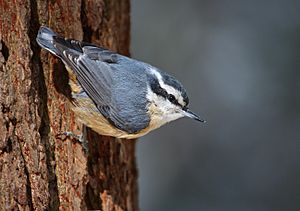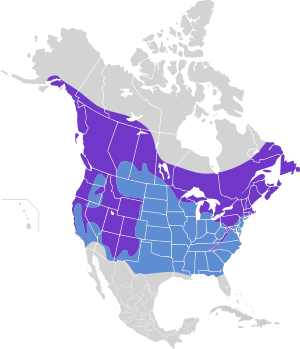Red-breasted nuthatch facts for kids
Quick facts for kids Red-breasted nuthatch |
|
|---|---|
 |
|
| Female | |
| Conservation status | |
| Scientific classification | |
 |
The red-breasted nuthatch (Sitta canadensis) is a small songbird found in North America. This bird has a blue-grey back and a rusty, cinnamon-colored belly. It also has a white throat and face, with a black stripe going through its eyes. Its head has a black cap, and its bill is straight and grey.
The nuthatch's call sounds high-pitched and a bit like a tiny trumpet. These birds live in conifer forests, which are forests with trees like pines and spruces. You can find them across Canada, Alaska, and parts of the United States. While they often stay in one place, they sometimes fly south if they can't find enough food.
Contents
About the Red-breasted Nuthatch Name
In 1766, a Swedish scientist named Carl Linnaeus officially named this bird Sitta canadensis. He used a name that a French zoologist, Mathurin Jacques Brisson, had used before.
The name Sitta comes from an Ancient Greek word for a similar bird, the Eurasian nuthatch. The second part of its name, canadensis, means "from Canada."
The word "nuthatch" is interesting! It comes from an old word, "nuthack." This name describes how the bird eats nuts. It wedges nuts into cracks in tree bark. Then, it "hacks" or hammers at them with its beak until they break open. The "red-breasted" part of its name simply describes the reddish color on the male bird's chest.
Scientists group the red-breasted nuthatch with four other similar birds. These are the Corsican nuthatch, Chinese nuthatch, Algerian nuthatch, and Krüper's nuthatch. They are all part of the "Sitta canadensis group." DNA studies show how these birds are related to each other. The red-breasted nuthatch is the only type of its species found across its wide home range.
What Does the Nuthatch Look Like?
The red-breasted nuthatch is a small passerine bird, which means it's a type of perching bird. It is about 4.5 centimeters (11.4 inches) long. Its wings can spread about 8.5 centimeters (21.6 inches) wide. This bird weighs around 9.9 grams (0.35 ounces).
Its back and upper tail feathers are bluish. Its belly and chest are a rusty, reddish-brown color. It has a black cap on its head and a black line that goes through its eye. Above this black line, it has a white "eyebrow" stripe. Both male and female nuthatches look similar. However, females and younger birds usually have duller head colors and lighter bellies.
Nuthatch Sounds and Calls
The red-breasted nuthatch makes high-pitched, weak, and nasal calls. People describe these calls as sounding like "yenk" or "ink." Some say they sound like a toy tin horn or a child's noisemaker.
Its song is a slow series of clear, nasal notes that rise in pitch. It sounds like "eeen eeen eeen" repeated slowly.
Where Do Red-breasted Nuthatches Live?
These birds mostly live all year in northern and high-mountain conifer forests. But they often migrate in an "irruptive" way. This means the number of birds migrating and where they spend the winter changes each year.
Sometimes, they fly as far south as northern Mexico. There, they are rare winter visitors to places like Nuevo León and Sinaloa. In the eastern United States, their living area is slowly moving further south.
The red-breasted nuthatch used to live on Isla Guadalupe, an island off Mexico. But they haven't been seen there since 1971. It is very rare for them to fly to Europe. Only two records exist of them being seen in western Europe. One bird even stayed through the winter in eastern England.
How Red-breasted Nuthatches Find Food
The red-breasted nuthatch is a very agile bird. It can climb up and down tree trunks and branches to find food. It often goes headfirst when climbing down a tree! It can even "walk" upside down on the bottom of branches. Unlike woodpeckers, it does not use its tail to help it climb. These birds usually look for food alone or in pairs.
What the red-breasted nuthatch eats changes with the seasons. In the summer, they mostly eat insects. Sometimes, they even catch insects while flying! In the winter, they switch to eating seeds from conifer trees. If you have a bird feeder, they might eat sunflower seeds, peanut butter, or suet. They often wedge food pieces into cracks in tree bark. This helps them break the food into smaller bits with their beaks.
Life Cycle and Reproduction
Like all nuthatches, the red-breasted nuthatch forms a pair bond with one partner. The male bird tries to attract the female with a special dance. He lifts his head and tail, turns his back to her, drops his wings, and sways from side to side.
This bird digs its own nest hole in dead wood. The nest is usually about 1.5 to 37 meters (5 to 120 feet) above the ground. Both the male and female work together to dig the nest. This can take anywhere from one to eight weeks.
The pair puts sticky tree sap around the entrance hole of their nest. This sap might help keep predators away. They line the nest with soft materials like grass, moss, shredded bark, and small roots. Both parents help build the nest, but the female does most of the work.
The female usually lays 2 to 8 eggs, but most often 5 or 6. The eggs are white, creamy, or pinkish, with reddish-brown speckles. They are about 0.6 to 0.7 centimeters (0.24 to 0.28 inches) long and 0.4 to 0.5 centimeters (0.16 to 0.20 inches) wide. The female sits on the eggs to keep them warm for 12 to 13 days.
When the chicks hatch, they are helpless and stay in the nest for 2 to 3 weeks. The female keeps them warm, but both parents feed them. Usually, they only have one group of chicks each year. Red-breasted nuthatches can live for about 6 years.
Conservation Status
The red-breasted nuthatch is doing well! It has a very large global range, and its population is growing. Because of this, the International Union for the Conservation of Nature (IUCN) lists it as a species of "Least Concern." This means it is not currently at risk of disappearing. In the Americas, this bird is protected by the Migratory Bird Treaty Act of 1918.
See also
 In Spanish: Trepador canadiense para niños
In Spanish: Trepador canadiense para niños



